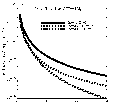| Line | lam, Å | Fline/FH-alpha | Lline/Msolyr-1, 1040 erg s-1 | Plots |
|---|---|---|---|---|
| Ly-alpha | 1216 | 8.7 | 98 | |
| H-alpha | 6563 | 1 | 11.2 | PS |
| H-beta | 4861 | 0.35 | 0.39 | PS |
| [OIII] | 5007 | 0.60 | 6.8 | PS |
| [OII] | 3727 | 0.18 | 0.21 | PS |
 Plot (PS|gif)
of Lyman-alpha flux against redshift,
for SFR of 1 Msol yr-1, for three different
cosmologies...
[here for SI units]
Plot (PS|gif)
of Lyman-alpha flux against redshift,
for SFR of 1 Msol yr-1, for three different
cosmologies...
[here for SI units]
Plot (PS) of Ly-alpha photon count rate against redshift, for SFR=1Msolyr-1 and for three different cosmologies.
Plot (PS) of comoving survey volume, in Mpc3, against redshift, assuming a redshift slice dz = 0.1, and field of view 8.5'x8.5', for three different cosmologies.
Plot (PS) of angular scale, for the same three cosmologies.
| H0 | OmegaM | OmegaL | VDAZLE | VALMA | VHDF | |
|---|---|---|---|---|---|---|
| 100 | 1.0 | 0.0 | 880 | 40 | 2300 | |
| 100 | 0.2 | 0.8 | 6560 | 265 | 1.4x104 | |
| 100 | 0.05 | 0.0 | 2.4x104 | 925 | 1.2x104 | |
| 65 | 0.04 | 0.0 | 1.0x105 | 3735 | 4.6x104 | |
| 65 | 0.25 | 0.0 | 2.3x104 | 900 | 2.6x104 |
Density of Ly-alpha emitters at z=4, with SFR=1 Msolyr-1 is comparable to phi*, however. Hierarchical cosmogonies (CDM) lead us to expect low-mass systems to dominate at high z, so these objects are far more representative of the early stages of galaxy formation than the bright submm sources. DAZLE's detection rate, in a small (dz=0.1) redshift slice, in the low-SFR regime, should rival LMA's with bright objects over a much larger (hence uncertain) redshift range.
Anthony Horton horton@ast.cam.ac.uk